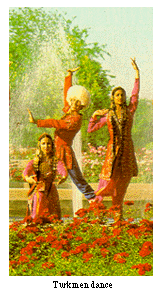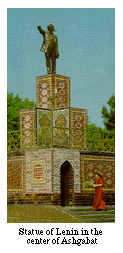
Soviet rule was established in Ashgabat in 1917. Soon after, however, the town was captured by the Whites. In 1918, the town was recaptured by the Soviets and renamed Poltorask, in honor of Turkistan Republic's Commissar for Labor, P. Poltorask. In 1927, when the Communist Party was established in Turkmenistan, the capital was renamed Ashgabat. Ashgabat, however, did not fully complied with the decrees from Moscow until the end of Stalin's reign of terror in the 1930's.
There are several folk etimologies for the name "Ashgabat," or "Ashgabad." The closest is the compound of the Arabic word for love (ishq) and the Persian suffix abad, meaning habilitated or built. The translation of the name would be "the city that love built" or the city that was built by love."

Between 1924, when it became the capital of the newly-formed Turkemanian republic, and 1948, when it was hit by a devastating earthquake, Ashgabat grew into an industrial town with about 65 factories in textile, metal working, and construction. The Kara Kum Canal, which reached Ashgabat in 1962 and which passes to the north of the city, has brought the city a great deal of prosperity. 900 miles away from where it takes source at the border of Afghanistan and Turkmenistan, the Kara Kum Canal forms a lake outside Ashgabat, providing the citizens with transportation, hydroelectric energy, recreational facility for boating in the middle of the desert.

In the center of a square, in the western part of Ashgabat, surrounded by trees, shrubs, and flowerbeds, the statue of Makhtumquli, the noted 18th century Turkmenian thinker, educator, and poet stands on a pedestal made of large and small rocks placed in the middle of a pool. Each spring, Turkmenian poets, writers, and intellectual gather together here and pay their respects to the founder of Turkmenian literature by reciting the poetry and by competing in forums created for the enhancement of Turkmenian arts.
the city proper, the major point of attraction is the statue of Lenin set on a high pedestal. The exterior of the pedestal is decorated with brightly-colored glazed tiles imitating the patterns of Turkmen carpets. A similar motif, it should be added, is used on the Turkmen flag. Nowhere else is Lenin's statue worked into the fabric of the culture like in Ashgabat.

Major places of interest in Ashgabat include the Turkmen Fine Arts Museum which, among other things, houses a collection of very beautiful Turkmen carpets. One of the carpets on display, among the largest and heaviest in the world, covers an area of 193.5 square meters and weighs 885 kilograms. The Turkmen History Museum contains over 30,000 archeological and ethnographic items dating back to the region's Parthian days. And the Exhibit Hall of the Ashgabat Carpet Factory with its collection of rare hand-woven carpets. A main feature of this Hall is a unique double-sided carpet.
There are a number of institutions of learning in Ashgabat. The most important of these institutions being the Academy of Sciences of Turkmenistan which houses the only Desert Institute in the former Soviet Union. To this we can add a number of agricultureal, medical, and technical institutions of higher learning.

